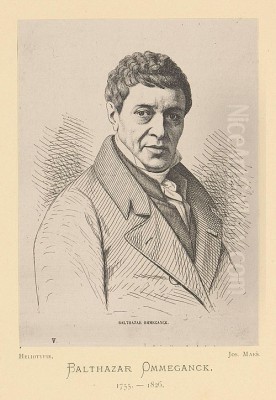
Balthasar Paul Ommeganck stands as a significant figure in the art history of the Southern Netherlands, particularly celebrated for his mastery of landscape and animal painting during the late 18th and early 19th centuries. Born in the bustling artistic hub of Antwerp on December 26, 1755, he dedicated his life and career to his native city, becoming a cornerstone of its artistic community until his death there on January 18, 1826. Ommeganck's work is often seen as a bridge, connecting the rich traditions of Dutch Golden Age landscape painting with the emerging sensibilities of Neoclassicism and early Romanticism, ultimately contributing significantly to the revival of Flemish landscape art.
His reputation was built on idyllic, meticulously rendered scenes of pastoral life, often bathed in a warm, gentle light. Sheep and cattle feature prominently in his work, depicted with anatomical accuracy and a sensitivity that suggests careful observation from life. Ommeganck was not merely a painter; he was also an influential teacher and a key organizer within the Antwerp art world, co-founding an important society dedicated to promoting the arts and serving as a professor at the prestigious Antwerp Academy. His legacy endures through his luminous paintings and his considerable impact on the subsequent generation of Belgian artists.
Early Life and Artistic Formation in Antwerp
Balthasar Paul Ommeganck's artistic journey began in Antwerp, a city with a storied artistic past, home to masters like Peter Paul Rubens and Antoon van Dyck. Growing up in this environment undoubtedly shaped his aspirations. His formal training commenced in 1767, when he became a pupil of the respected, though perhaps less internationally renowned, animal and landscape painter Henricus Joseph Antonissen (also known as Hendrik Jozef Antonissen). Antonissen himself specialized in pastoral scenes, often featuring cattle, providing a direct lineage for Ommeganck's own thematic preferences.
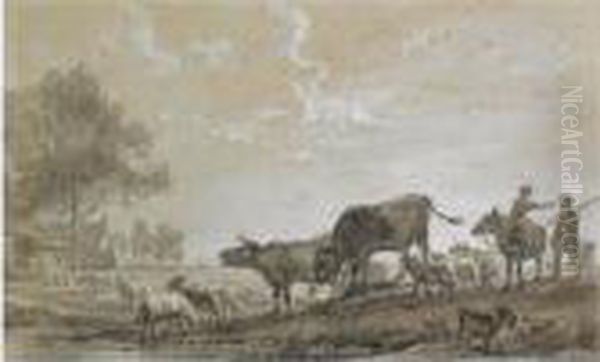
Under Antonissen's guidance, Ommeganck would have learned the fundamentals of drawing, composition, and oil painting techniques prevalent at the time. The emphasis was likely on careful observation of nature, combined with established compositional formulas derived from 17th-century Dutch and Flemish masters. This training instilled in Ommeganck a deep appreciation for detailed rendering and the harmonious integration of animals within landscape settings, skills that would become hallmarks of his mature style. His early years were thus spent honing his craft within the specific traditions and artistic milieu of late 18th-century Antwerp.
Artistic Style: Observation, Idealization, and Light
Ommeganck's style is characterized by a unique blend of detailed realism and gentle idealization. He possessed a remarkable ability to capture the textures of animal fleece, the specific quality of foliage, and the atmospheric effects of light, particularly the warm glow of early morning or late afternoon sun. This meticulous attention to detail aligns him with the long tradition of Flemish and Dutch fine painting. However, his compositions often transcend mere topographical accuracy; they present a serene, harmonious vision of nature, an idealized pastoral world untouched by hardship.
His work shows the influence of Neoclassicism in its clarity, balanced compositions, and smooth finish. Yet, there's also a burgeoning Romantic sensibility in the emotive quality of the light and the peaceful, almost reverent, depiction of the natural world. Ommeganck was particularly renowned for his portrayal of sheep, earning him nicknames like the "Raphael of Sheep." He masterfully rendered their forms and fleece, capturing their placid nature within tranquil landscapes that often evoke the Campine region near Antwerp or the rolling hills of the Ardennes.
The influence of the Dutch Golden Age is palpable in his work. Ommeganck deeply admired 17th-century masters known for their pastoral scenes and luminous landscapes. He looked particularly to artists like Paulus Potter, famed for his depictions of cattle (Ommeganck's Cow in a Landscape is often compared to Potter's The Young Bull), and Aelbert Cuyp, celebrated for his mastery of golden light bathing Dutch landscapes. Echoes of Italianate Dutch painters like Nicolaes Berchem and Karel Dujardin, who specialized in idyllic pastoral scenes, can also be discerned in Ommeganck's approach to subject matter and atmosphere.
Key Themes and Subjects
The dominant theme throughout Ommeganck's oeuvre is the pastoral landscape. His canvases typically feature tranquil countryside settings – meadows, gentle hills, riverbanks, and wooded areas. These landscapes are rarely wild or dramatic; instead, they exude peace and stability. They serve as the stage for his meticulously painted animals, primarily sheep and cattle, often accompanied by a solitary shepherd or herder figure. These figures are usually small in scale, emphasizing the dominance and serenity of nature.
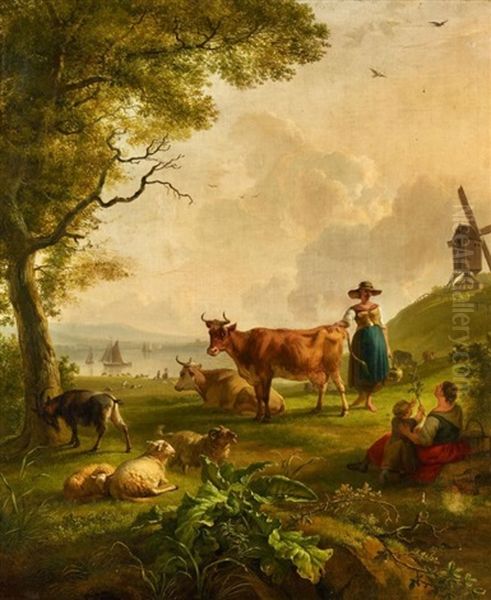
Animals, especially sheep, were Ommeganck's forte. He depicted them not just as generic elements but with individual character, often shown resting, grazing, or wading through shallow streams. His skill in rendering their woolly textures and capturing their calm demeanor was widely praised by his contemporaries. The interaction between the animals and their environment is always harmonious, contributing to the overall idyllic mood of his paintings.
Light plays a crucial role in Ommeganck's work. He favored the soft, warm light of morning or evening, which creates long shadows, enhances textures, and imbues the scenes with a gentle, sometimes melancholic, atmosphere. This careful manipulation of light contributes significantly to the idealized and slightly nostalgic quality that characterizes much of his output. His landscapes are not just records of places but carefully constructed visions of rural peace.
Representative Works
Several paintings exemplify Ommeganck's style and thematic concerns:
_Landscape with Cows, Goats and Sheep in a Meadow and Herder_ (Versions exist, e.g., 1781, 1783): These works showcase his typical subject matter – a peaceful pastoral scene populated by various farm animals rendered with care, often near a water source, under a soft light. The composition is balanced, the details are precise, and the overall mood is one of tranquility. The slight variations in titles and dates found in records likely refer to closely related compositions on this favoured theme.
_Cow in a Landscape_ (c. 1780-1789): This painting is noted for its connection to the European trend of depicting livestock prominently in landscapes, drawing clear inspiration from Paulus Potter's iconic The Young Bull. It highlights Ommeganck's skill in animal portraiture within a natural setting, bathed in his characteristic warm light.
_Fording the Stream_ (1802): This title suggests a common motif in his work, depicting animals crossing a shallow river or stream. Such scenes allowed Ommeganck to explore reflections in water and the interaction of animals with the landscape elements, adding dynamism to the otherwise serene compositions.
_Weidetiere und Hirten am See_ (Pastoral Animals and Shepherds by the Lake, c. 1783): The German title points to the international recognition Ommeganck received. This work, described as signed and dated, likely presents another variation of his preferred pastoral theme, emphasizing the harmony between livestock, human figures (shepherds), and a tranquil lakeside environment.
_Landscape with Sheep_ (1814): A later work, this painting likely focuses on his most celebrated subject. It would demonstrate his mature style, possibly with even greater refinement in the rendering of the sheep and the atmospheric landscape they inhabit.
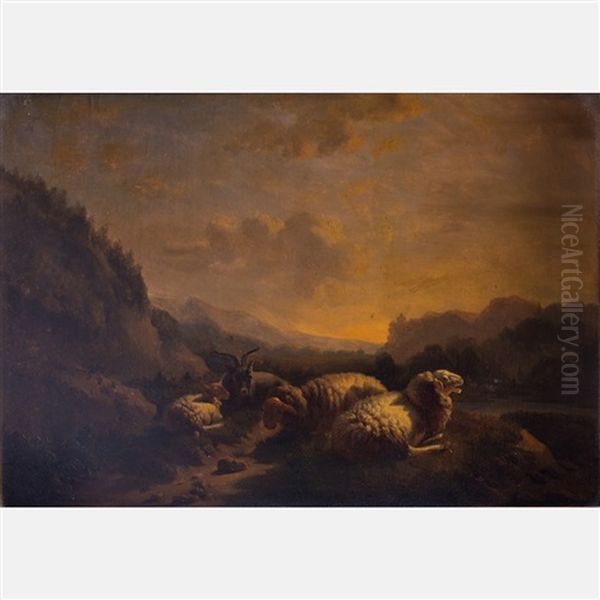
_Sheep and Ram Resting in a Landscape_: Described as a later work, this piece would again emphasize his specialization, focusing closely on the forms and textures of the resting animals within a carefully composed natural setting.
It is worth noting that some sources mention a work titled By the Stream dated 1755; this date coincides with his birth year and is almost certainly an error in transcription or documentation. Ommeganck's productive period began significantly later.
Leadership in the Antwerp Art Scene
Ommeganck was more than just a successful painter; he was a proactive force in Antwerp's artistic life. In 1788, alongside other artists, he played a crucial role in founding the Konstmaatschappij (Art Society), later known as the Antwerp Royal Society for the Encouragement of Fine Arts (Société Royale pour l'encouragement des Beaux-Arts à Anvers). This society aimed to revitalize the arts in Antwerp, providing exhibition opportunities and fostering a sense of community among artists during a period of political and social change leading up to the French Revolution.
His leadership qualities were recognized early on. In 1789, just a year after its founding, Ommeganck became the dean or president of the Konstmaatschappij. This position placed him at the center of artistic activities and debates in the city. He was known to be a staunch defender of the traditional Flemish painting style, rooted in the legacy of 17th-century masters, during a time when French Neoclassicism, championed by figures like Jacques-Louis David, was gaining prominence across Europe. Ommeganck navigated these stylistic tensions, advocating for the enduring values of detailed observation and skilled craftsmanship inherent in the Flemish tradition.
His commitment to art education was further solidified in 1796 when he was appointed a professor at the prestigious Antwerp Academy (Academie voor Schone Kunsten Antwerpen). This institution was a vital training ground for young artists, and Ommeganck's role allowed him to directly influence the next generation. He likely taught landscape and animal painting, passing on the techniques and aesthetic principles he valued. His colleagues at the Academy and fellow members of the art society would have included prominent Antwerp artists of the time, such as the Neoclassical painter Andries Cornelis Lens and the influential history painter and teacher Willem Jacob Herreyns, as well as specialists like the flower painter Pieter Faes.
Wider Recognition, Influence, and Later Life
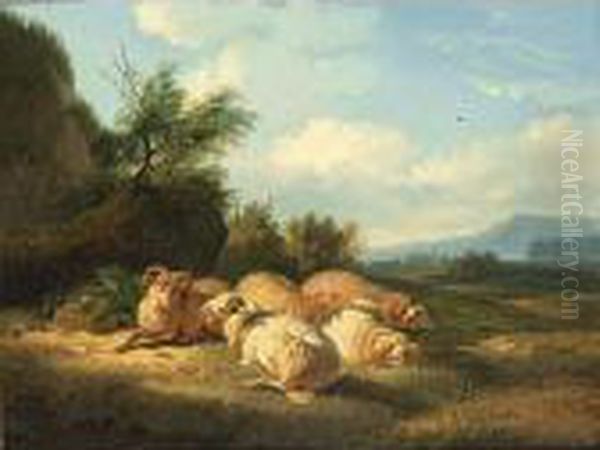
Ommeganck's reputation extended well beyond Antwerp. His paintings were highly sought after by collectors both within the Low Countries and internationally. He frequently exhibited his works at the prestigious Paris Salon, the most important art exhibition in Europe at the time. Success at the Salon brought international fame and often led to official honors and commissions, contributing significantly to his standing and the market value of his paintings. His works commanded high prices during his lifetime and continued to be popular on the art market after his death, appearing regularly in auctions.
A testament to his respected position came in 1815, following the final defeat of Napoleon. Ommeganck was appointed by the authorities of the newly formed United Kingdom of the Netherlands to a commission tasked with overseeing the recovery and return of artworks that had been looted from Antwerp churches and institutions by French forces during the occupation. This role required diplomatic skill and art historical knowledge, indicating the high regard in which he was held by both the artistic community and the administration.
Ommeganck's influence on subsequent generations of Belgian painters, particularly those specializing in landscape and animal subjects, was considerable. He is seen as a key figure in the revival of landscape painting in the region, maintaining a high standard of technical skill and detailed observation while adapting to contemporary tastes. Artists like Eugène Joseph Verboeckhoven, who became one of the most famous Belgian animal painters of the 19th century, clearly followed in Ommeganck's footsteps. Others involved in the broader renewal of Belgian art, such as the historical painter Hendrik Leys or the landscape painter Jean-Baptiste De Jonghe, would have been aware of Ommeganck's work and his role in upholding local traditions. His style provided a foundation upon which later Romantic and Realist landscape painters could build. Even contemporaries working in landscape, like the Flemish painter Simon Denis (though often based in Italy), were part of the same broader European movement exploring nature.
Balthasar Paul Ommeganck continued to paint and remain active in Antwerp's art circles until his later years. He passed away in his native city on January 18, 1826, at the age of 70.
Addressing Historical Discrepancies
While researching Ommeganck, certain confusing or contradictory pieces of information sometimes surface, often due to errors in older sources or confusion between individuals with similar names. It is important to clarify these:
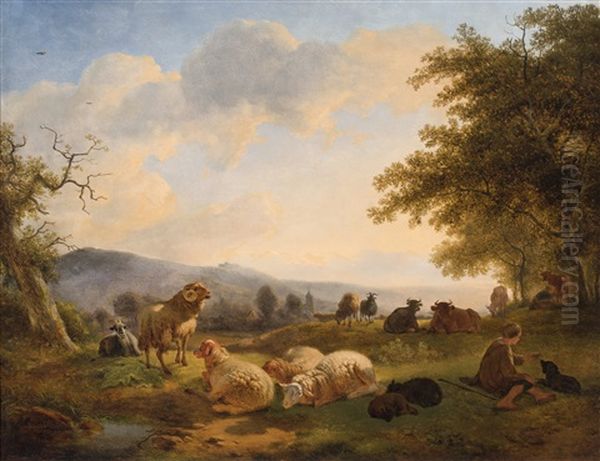
One notable point of confusion involves a dramatic story about a certain "Balthasar Ommeganck," described as a stone mason's assistant, who was allegedly involved in a plot to commit arson at the Amsterdam Exchange in 1622 and was subsequently executed. This event and individual have absolutely no connection to the painter Balthasar Paul Ommeganck (1755-1826). The dates are over a century apart, and the profession is entirely different. This appears to be a case of mistaken identity or a conflation of unrelated historical anecdotes associated with the surname.
Another discrepancy appears in some sources mentioning Ommeganck authoring articles on painting techniques in 1845 and 1852. These dates are impossible, as the painter died in 1826. It is likely that these references are either incorrect, refer to publications about Ommeganck released posthumously, or perhaps attribute writings by a different individual (possibly a descendant or another artist with a similar name) incorrectly to him. Balthasar Paul Ommeganck's contributions were primarily through his paintings and his teaching during his lifetime.
Legacy and Conclusion
Balthasar Paul Ommeganck occupies a respected place in Belgian art history. He was a master technician whose detailed, luminous landscapes and sensitive animal depictions were highly prized during his lifetime and continue to be admired. He successfully navigated the transition between Neoclassicism and Romanticism, creating a style that honored the legacy of the Dutch and Flemish Golden Age while appealing to contemporary sensibilities. His preferred subjects – serene pastoral scenes featuring sheep and cattle – became synonymous with his name.
Beyond his personal artistic achievements, Ommeganck played a vital institutional role in Antwerp. As a co-founder and leader of the Konstmaatschappij and a professor at the Academy, he actively worked to support artists, promote Flemish art, and educate the next generation. His efforts contributed significantly to the artistic vitality of Antwerp and the broader revival of landscape painting in the Southern Netherlands (later Belgium) in the early 19th century. He remains a key figure for understanding the continuity and evolution of landscape painting traditions in the region, leaving behind a legacy of beautifully crafted images that celebrate the tranquility and harmony of the natural world.